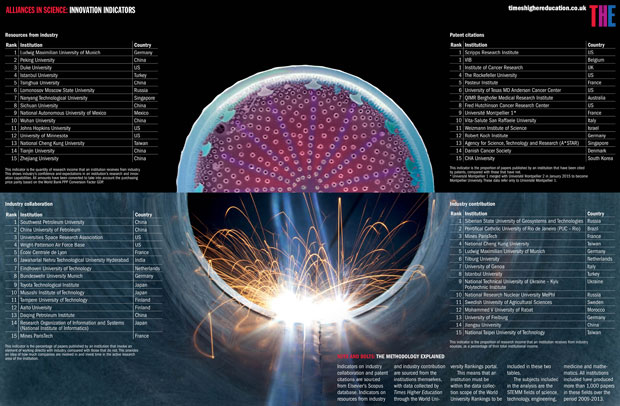A cloak with the magical power to make things under it invisible? Authors have fantasised about the possibilities of such a garment for centuries, but in 2006 scientists declared that fiction had become reality with the invention of a device that makes objects disappear – at least when viewed in the microwave spectrum. Crafted from synthetic “metamaterials”, the cape is the result of a collaboration between scientists at Duke University, Imperial College London and Sensormetrix, a California-based company that develops technology for governmental and defence clients. As the technology advances, scientists say that it could be used in military operations, to disguise vehicles, for example. David Smith, the James B. Duke professor of electrical and computer engineering at Duke, says Sensormetrix was instrumental in the financing and construction of the cloak sample.
Such university-industry partnerships are increasingly common as higher education institutions around the world seek to enhance their research, find new applications for their work and boost revenues.
In the UK, interactions between universities and the economy increased in volume by 10 per cent between 2012-13 and 2013-14 through activities such as collaborative and contract research, consultancy and intellectual property income. Figures released by the Higher Education Funding Council for England last month suggest that the worth of these partnerships grew by £300 million to £3.9 billion during the same period.
According to Robert Tijssen, chair of science and innovation studies at Leiden University in the Netherlands, alongside societal engagement, “university-industry connectivity is now the third mission of a university, next to teaching and training and research”.
Data published by Times Higher Education this week in collaboration with Elsevier aim to shed new light on the world of university innovations and inventions by revealing which institutions show the strongest performance across four indicators: the ratio of papers co-authored with industry, the proportion of papers cited by patents, the quantity of research income from industry and the proportion of research income from industry.
Many of the institutions that perform well have not featured prominently, or at all, in Times Higher Education’s World University Rankings because they do not have breadth of research or teaching. However, they are exceptional within a specific field.
Across the indicators, the US and China dominate, with nine and 10 institutions respectively in our tables. Only one UK institution – the Institute of Cancer Research – features.
China’s Southwest Petroleum University has the highest percentage of papers co-authored with industry while the US’ Scripps Research Institute, which conducts biomedical research, produces the highest proportion of papers that have been cited by patents. Ludwig Maximilian University of Munich, one of Germany’s oldest universities, claims the largest quantity of research income from industry, and the Siberian State University of Geosystems and Technologies has the highest proportion of income from industry sources.
Some institutions perform strongly across several of the innovation indicators. Among them is France’s Mines ParisTech, which specialises in engineering, science and mathematics. Ranked in the 226-250 band in last year’s THE World University Rankings, it receives the third-highest proportion of research income from industry of any higher education institution and also produces a high proportion of papers co-authored with industry, achieving 15th place on the latter measure.
Alliances in science: innovation indicators
Click to view high-resolution version
Damien Goetz, director of research at Mines ParisTech, explains that about 80 per cent of the institution’s annual €90 million (£64 million) budget is devoted to research. A little less than half of this pot comes from the state, while the rest comes from private funding – either directly from industry (about €17.5 million) or from European research grants – and the institution signs 600 contracts with industry partners each year.
The salaries of 150 out of a total of 428 academics are paid entirely through research contracts, which means that the university must secure enough funding in this way to be able to cover their salaries.
Goetz admits that some academics might think of the university’s funding model as “dangerous”, with the institution forced to sign industry contracts “just because it needs the money”, but he insists that this is not the case. The institution maintains its independence by ensuring that no single partner is responsible for a large proportion of funding; the five largest partners generate just one-tenth of its total research activity.
Mines ParisTech has only a small number of students: about 460 study the equivalent of the final year of a bachelor’s degree and a two-year master’s, a further 203 students take specialist master’s courses and there are 386 doctoral students.
In the past, the institution’s focus on industry collaboration meant that it took “less care” than it might have done to enhance the academic visibility of its research, admits Goetz, but that has changed. Today, there is “more pressure on researchers and teachers to make sure that when they have done something in partnership with industry they continue work until publication”, he says. “The tendency was to say, ‘OK, it’s used by the industry, let’s move on to something else’ and not take the time necessary to publish the best papers internationally.”
Working with industry also has significant advantages, he argues: “There is no risk that our research becomes too academic, too far from real life and too far from any application in the near future.”
A similar belief lies behind Duke University’s innovation and entrepreneurship initiative, launched in 2010. A private university in the US with almost 15,000 students – most of whom major in economics, public policy, biology, psychology or biomedical engineering – Duke receives the third-highest quantity of research income from industry of any higher education institution in the innovation indicators, and is one of just two institutions in the tables to appear in the top 20 of last year’s THE World University Rankings.
The aim of the innovation and entrepreneurship initiative is to take ideas and “turn them into real actions that have a real impact on real people’s lives”, says Eric Toone, the project’s director.
“I think we have a responsibility to use taxpayers’ dollars to solve societal problems in a way that really impacts people’s lives rather than just publishing journal articles,” he says. “That’s not to say publishing journal articles is not important – it’s incredibly important – but I think it’s incumbent on the university to go further.”
Examples include a new treatment for Pompe disease, an inherited disorder that disables the heart and skeletal muscles, and a high-resolution gigapixel camera that could enhance television sports coverage.

But Duke has a series of ground rules for working with business: “We can’t do any deal that says ‘we’ll do the research and you’ll own the IP’. We would never take any money where we could not publicly disseminate the results of any research. The university philosophically, and then as a matter of law, can never function as a research arm of a corporation.”
The Netherlands’ Eindhoven University of Technology, which produces the seventh-highest proportion of papers co-authored by industry, according to the innovation indicators, also refuses to conduct research with industry that cannot be published.
But Eindhoven’s collaboration with business goes further than that of many institutions. Of its 300 professors, half work full time and are employed by the university. The other half are part time, and about 80 per cent of staff in this group are employed by industry, splitting their time between working at the university and working in business.
The university agrees to fund half the cost of long-term research programmes with industry, as long as the academics involved can secure the rest of the funding from business. According to Jan Mengelers, president of the institution, one-third of its €300 million annual budget comes from industry or European funding, with the rest from government.
Eindhoven can attribute part of its success to its proximity to high-tech, multinational companies including Philips and NXP Semiconductors. The teaching programmes at the university sit under three themes based on these companies – smart mobility, health and energy.
“We have an enormous amount of research done by PhD students in industry for the practical part of their final year,” explains Mengelers. “That’s a unique selling proposition of ours. We say bachelor’s students can create their own course, master’s students can create their career, and then graduates can get their first job next to the university.”
Advocates for industry collaboration argue that it provides universities with income for research at a time when government funding is declining in many countries, as well as creating new research and development opportunities, increasing student employability and giving institutions a greater chance of solving “real-world” problems.
But some warn universities to tread carefully when working with business, arguing that the independence of university research can be compromised through such partnerships if they are not well managed. For Cary Nelson, professor of English at the University of Illinois at Urbana-Champaign, and former president of the American Association of University Professors, the answer is to lay down a clear set of ground rules before such partnerships proceed.
The AAUP book Recommended Principles to Guide Academy-Industry Relationships (2014) outlines 56 principles universities should adopt to protect their independence. These include the right for academics to publish their research with a maximum of 60 days’ delay, the prohibition of academics from engaging in industry-led ghostwriting and a requirement for academic staff to report all significant outside financial interests relating to their professional responsibilities. It states that these principles must be public, as should any research contracts with industry.
Nelson cites the example of BP reportedly hiring scientists after the Gulf of Mexico oil spill in 2010 under contracts which stated that they must not publish the research or speak about the data for at least three years, or until the government gave the final approval to the company’s restoration plan for the whole of the Gulf. “That was one of my few really public interventions. I criticised BP for that in public and BP stopped making that demand. But some faculty members and students had signed contracts agreeing to the regulations,” he says.
Even collaborations that minimise the risks create a sense of indebtedness, he argues, adding that research shows that all it takes is a gift of some stationery for someone to feel a bias in favour of the giver. He says that if institutions implement the AAUP’s principles, they can, however, ensure that the benefits of industry collaborations outweigh the risks. “The general principle behind the project was: this stuff is happening and it can’t be stopped so the question is how to manage it,” he says.
So why do China and the US dominate the innovation indicators?
Simon Marginson, professor of international higher education at the UCL Institute of Education, says that the results reflect the strengths of different countries in particular industries, such as engineering and communications, but also their research strategies and policies.
In China, for example, universities receive only 8 per cent of national research funding directly, but they also work closely with government-controlled enterprises that receive the majority of China’s R&D funds.
“In this environment there is continuous higher education-industry interaction and collaboration, a good deal of personnel mobility, some joint appointments, and joint publishing is normal,” Marginson explains.
Meanwhile, in the US, universities and their spin-off companies can be commercial players in their own right, thanks to the 1980 Bayh-Dole Act, which gives universities ownership rights over their inventions.
The Hefce Higher Education – Business and Community Interaction Survey: 2013-14 suggests that UK universities as a whole outperform those in the US and Japan in terms of their proportion of industry-funded research and income from spin-off equity – yet at the level of individual institutions, the THE innovation indicators suggest that the UK performs far less well.
Marginson argues that the UK must look closely at how it promotes the take-up of research by industry if it wants to be at the cutting edge of university-industry relations.
“As long as the rewards for investment in financial assets are higher than the rewards for investment in knowledge-intensive industry innovation, the latter will be neglected,” he says.
“This is a serious problem in the UK economy, where finance generating finance often seems to be the main game.”

He adds: “It is simply not possible to develop the active promotion of R&D-driven industry at the global cutting edge within the framework of a fiscal policy of austerity. Financial austerity is good for the commercial finance sector in the City of London, but not good for industry innovation.”
Meanwhile, Craig Klafter, rector of the American University of Myanmar, points to different global practices in the area of patents.
One factor, he suggests, is the level of qualification held by patent and technology officers. At US universities, such staff tend to have undertaken a law degree and then a PhD in science or engineering, which “gives them a certain credibility with researchers”. Such high levels of qualification are far less common among their counterparts in Europe.
“In North America, staff at patent offices have a running dialogue with researchers, helping to guide their research into areas that are not heavily controlled by patents,” Klafter explains.
And researchers in North America typically receive between 25 and 60 per cent of the royalties earned from the commercialisation of a patent, Klafter adds, while, in China, academics are given a bonus salary for patenting, even if it is not commercialised. Researchers in Europe get a “minuscule proportion” of royalties in comparison.
“I know top-notch researchers in engineering in the UK who won’t accept EU funding precisely because of the aggressive attitude the EU has on claiming ownership of intellectual property that comes out of their work,” says Klafter.
Others argue that greater recognition of universities’ work with industry would drive improvement.
In university rankings, “there are a lot of things that aren’t currently recorded in some of the indicators for performance activity that need to catch up”, says Julian Beer, pro vice-chancellor for research, enterprise and business engagement at Birmingham City University.
League tables reward universities “for spin-offs and IP from the university”, he says, but not for “working with businesses when it’s their IP. They’re equally valid, I would have thought, for the local economy.”
Arun Sharma, deputy vice-chancellor for research and commercialisation at Queensland University of Technology, believes that there is a need for new rankings focused on university-industry links: “If there were league tables on industry collaboration or research impact there would be greater incentive for universities to link with businesses or carry out research that is likely to be picked up by businesses.”
For Beer, the importance of such work is clear. “Innovation is the lifeblood of any society or any economy,” he says. “We have a role, I believe, as universities, to be orchestrators of growth – and innovation plays a key part in that.”
Recording connectivity: what, how and why
The impact that a university has on the economy and our wider society through its innovations and inventions has never been higher on the global agenda.
In the East, abundant funding and reforms designed to develop world-class universities have been justified by the need to put higher education at the heart of new knowledge economies, to secure future financial prosperity. In the West, in times of economic austerity, universities are increasingly asked to prove their economic impact in order to justify their share of scarce public funding, in competition with schools, hospitals and other public services.
And across the world, ever more discerning prospective students demand more information on which universities have rolled up their sleeves to get close to the “real world” of industry and offer them better business connections and employment opportunities.
But while such activity is so high on the agenda that its traditional description as “third mission” now seems quaintly anachronistic, it has never been adequately reflected in the burgeoning range of metrics used to measure and assess our universities around the world.
Indeed, Times Higher Education has been the pioneer here. Its World University Rankings are the only global rankings to take account of such activity at all. Among the rankings’ 13 performance indicators, one examines the amount of research income a university attracts from business – showing how much each university has persuaded businesses, in the face of much competition, to back it with investment. Two tables published in this feature draw on that data.
But we want to do better.
It is clear that many of the most desirable indicators and most important aspects of university performance, especially beyond immediate economic impact, are extremely difficult to capture. Indeed, in the UK, the solution to capturing such activity has been to gather, as part of the research excellence framework, almost 7,000 individual narrative case studies from universities on the impact of their research, and to have panels of experts evaluate them all, at a cost of £55 million. This model is not going to be practical to replicate on a global scale.
The series of tables we are publishing today, examining industrial collaboration, industry income and intellectual property, are designed to start a conversation. What other indicators might we develop, how might they be combined and could we work towards a full innovation and impact university ranking? Let us know your thoughts. Email rankings@timeshighereducation.com.
Phil Baty is rankings editor at Times Higher Education.
POSTSCRIPT:
Print headline: Breaking new ground
Register to continue
Why register?
- Registration is free and only takes a moment
- Once registered, you can read 3 articles a month
- Sign up for our newsletter
Subscribe
Or subscribe for unlimited access to:
- Unlimited access to news, views, insights & reviews
- Digital editions
- Digital access to THE’s university and college rankings analysis
Already registered or a current subscriber? Login







